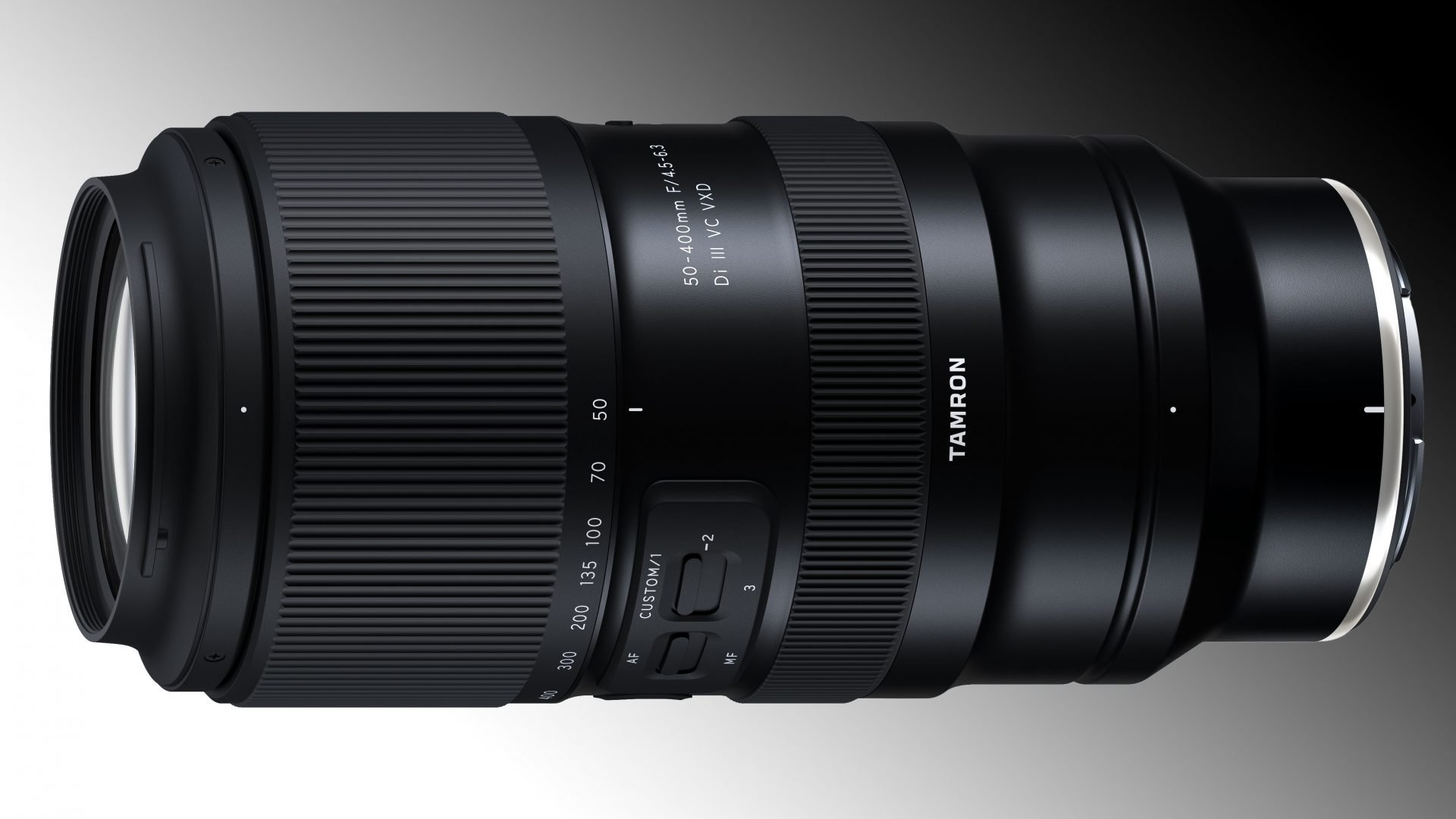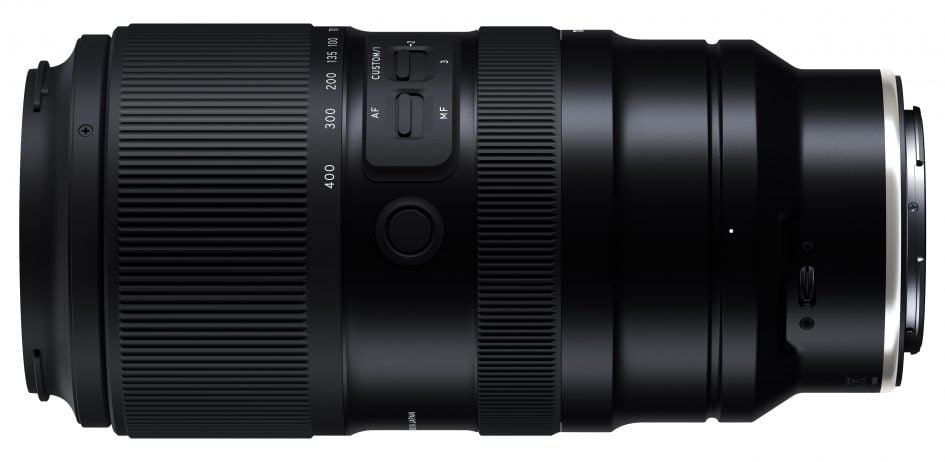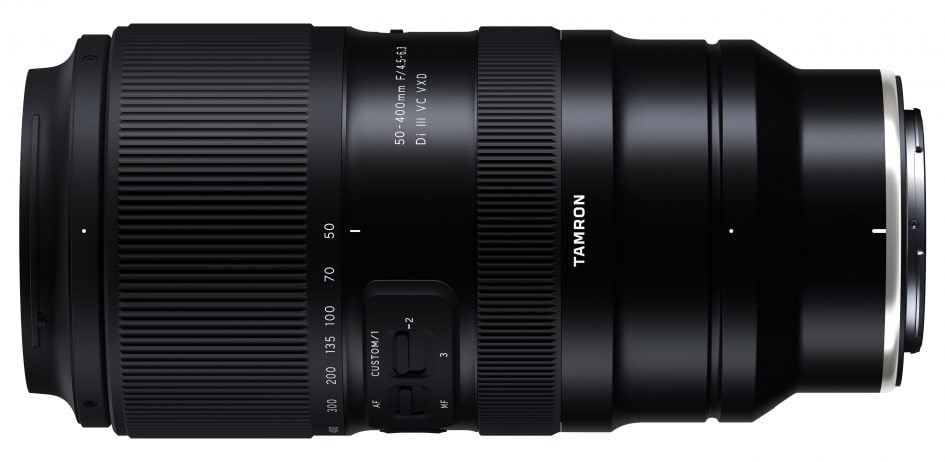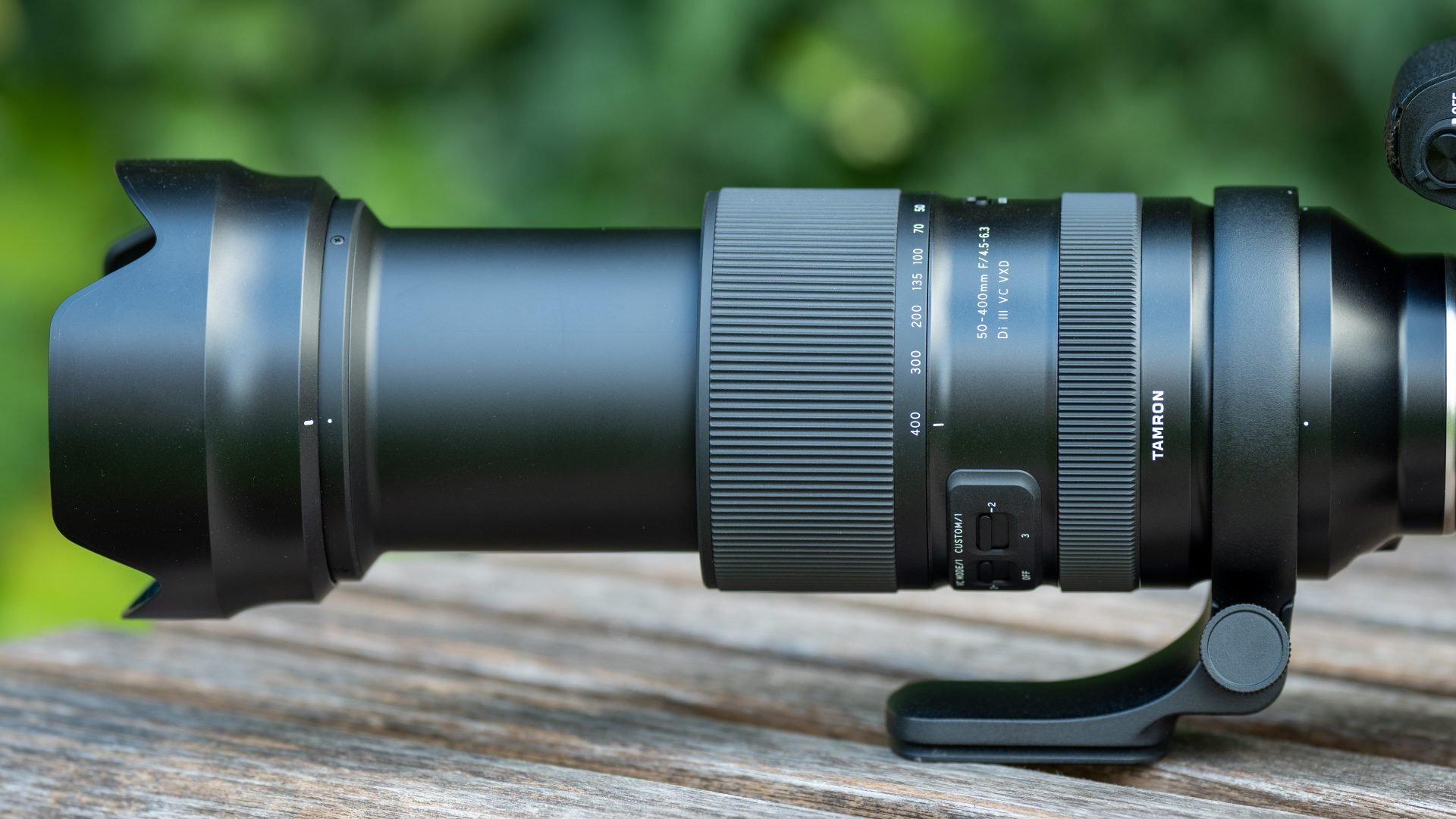Tamron 50-400mm f4.5-6.3 Di III VC Nikon Z review so far
-
-
Written by Thomas
Tamron’s 50-400mm f4.5-6.3 Di III VC VXD (model A067Z) is their fifth zoom lens for Nikon’s Z-mount and covers a huge 8x zoom-range. Its optical formula is the same as the Sony E-mount version which was introduced in 2022. The lens is corrected for full-frame sensors and features optical image stabilization (VC) – an essential feature for long telephoto lenses. It also is fully weather-sealed including fluorine coating on the front lens and Tamron offers a removable tripod-collar with Arca-Swiss style tripod interface as optional accessory. And for those who like to capture small objects the 50-400mm f4.5-6.3 Di III VC allows for a maximum magnification of 1:2 at the wide end and 1:4 at the long end with a good working distance.
The lens is made in Vietnam and costs 1399 EUR / 1299 USD / 1249 GBP. It should become available September 19th. PS – if you’re interested in Tamron’s other full-frame telephoto zoom lenses available for Z-mount check out my in-depth reviews of the Tamron 35-150mm f2-2.8 Di III and Tamron 150-500mm f5-6.7 Di III VC (tested on a Sony A7R II), plus the Tamron 70-300mm f4.5-6.3 Di III and Tamron 28-75mm f2.8 Di III G2 (tested on a Nikon Z7/Z8).
Facts and features
Let’s compare the Tamron 50-400mm f4.5-6.3 Di III VC (“Tamron” for short) to the Nikon Z 28-400mm f4-8 VR (“Z 28-400mm”) and the Nikon Z 100-400mm f4.5-5.6 VR S (“Z 100-400mm”) As usual I’ve rated the features with a [+] (or [++]), when it’s better than average or even state of the art, a [0] if it’s standard or just average, and [-] if there’s a disadvantage.
Size (diameter x length): 89 x 186mm (3.5 x 7.3in.) plus 46mm for the lens hood. The Z 28-400mm is 85 x 142mm + 24mm lens hood, the Z 100-400mm is 98 x 222mm + 65mm lens hood. All lenses in this comparison extend when zoomed to their longest focal length: The Tamron extends to a maximum total length (incl. lens hood) of 307mm, the Z 28-400mm to 262mm, the Z 100-400mm to 336mm. The Tamron and the Z 28-400mm feature a zoom-lock, the Z 100-400 doesn’t need one. [0]
Weight: At 1180g (2.6 lb.) plus 54g for the lens hood the Tamron is 478g (1.1 lb.) heavier than the Z 28-400mm at 725g + 31g lens hood. The Z 100-400mm is 1355g + 63g lens hood. The optional tripod collar adds another 146g to the Tamron. [0]
Optics: The Tamron is a pretty complex design with 24 elements in 18 groups including 5 special dispersion elements and 2 aspherical elements. It also has fluorine coating at the front lens to repel water, dust, and dirt and make cleaning easier. The Z 28-400mm is a 21/15 design and does not have fluorine coating at the front, the Z 100-400mm is 25/20 and has fluorine coating. [+]
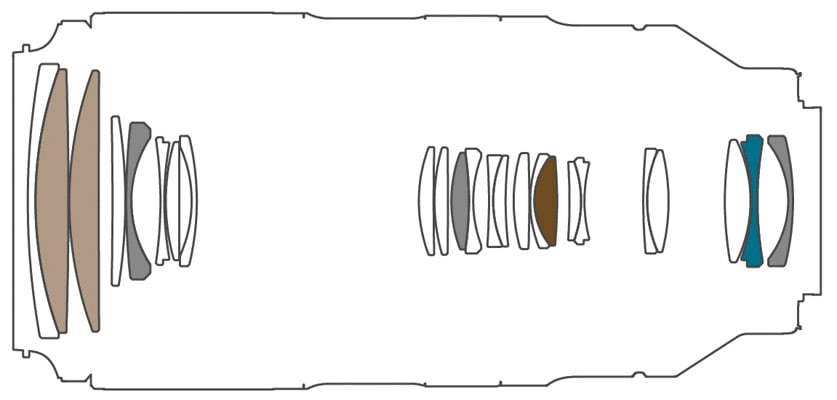
Minimum object distance is 0.25m (0.8ft.) with a magnification of 1:2 and a working distance of 5cm (2in.) at 50mm focal length. At 400mm focal length maximum magnification is 1:4 (or 1:3.8 in manual focus) which is still quite good and results in a much longer working distance of around 1.2m (3.9ft.) even with the lens hood attached. For details see table below. Minimum object distance of the Z 28-400mm is 0.2m at the short end (1:2.6 magnification) and 1.2m at 400mm (1:3.1 magnification), the Z 100-400mm achieves 1:2.5 at 0.97m and 400mm focal length. [+]

Focal ratio: All three lenses have a focal ratio which becomes smaller the further you zoom in. The Tamron starts at f4.5 at 50mm focal length and reduces its focal ratio to f5.0 from 61mm, f5.6 from 87mm and f6.3 from 158mm onwards. The Z 28-400mm maintains its maximum focal ratio of f4.0 only up to 31mm focal length. F5.6 is reached at 50mm, f6.3 at 89mm and f8.0 from 190mm onwards. So the Tamron is around 1/3 – 2/3 of a stop brighter at comparable focal lengths than the Z 28-400mm but slower than the Z 100-400mm. [+]
Filter-thread: 67mm for the Tamron, 77mm for both Z-Nikkors. [+]
Image stabilization: All lenses in this comparison offer optical stabilization which works in conjunction with the body-based stabilization on Nikon’s full-frame Z cameras. Both Z-Nikkors have a claimed 0.5 stop advantage from Synchro-VR on modern Nikon Z cameras. [+]
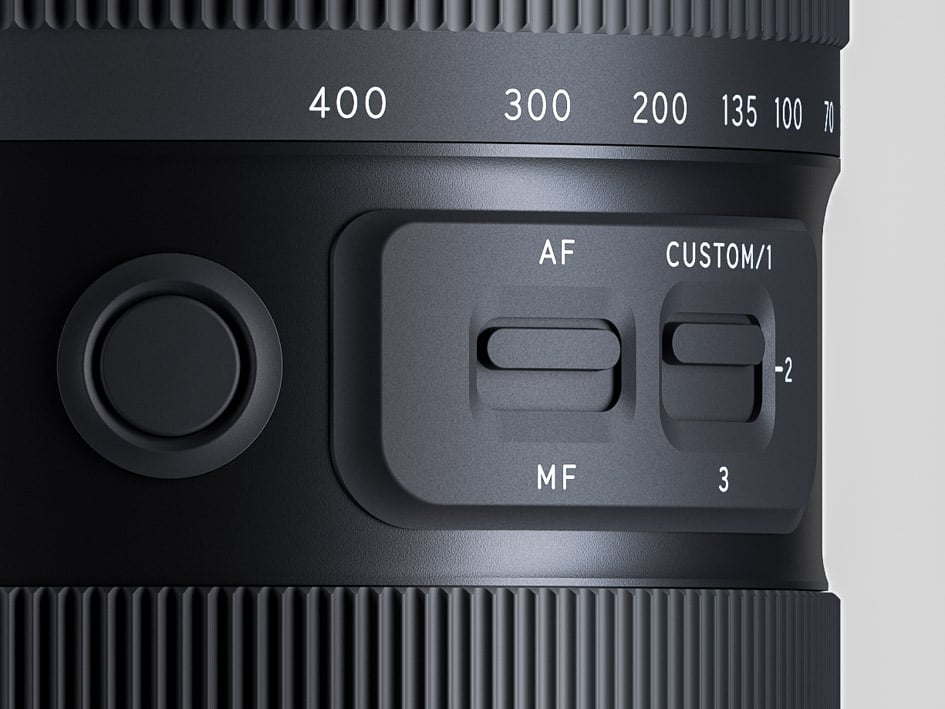
Aperture ring and other control elements: Neither the Tamron nor the Z-Nikkors have a designated aperture ring. But you can assign the focus set button on the Tamron to switch the focus ring to operate the aperture. You can also assign other functions to the focus set button apart from the usual focus preset e. g. make the focus automatically shift between two focus positions A and B or assign a function from the camera body. The additional custom switch allows for three different settings for the focus set buttons and focus ring and you can also define a function to limit closest focus to 5/7/10m. Some of these functions can be set from the camera (menu f2: Custom controls) but for others you need Tamron’s Lens Utility (TLU) and connect the lens to a computer or smartphone via USB-C cable. This is also the way to update the firmware of the lens. The multi-function control ring of the Z 28-400mm can be assigned to operate the aperture, exposure compensation, ISO or focus. It automatically falls back to its customary focus control when the camera is switched to manual focus. The Z 100-400mm has a separate focus ring in addition to the multi-function ring. [+]
Autofocus: All three lenses in this comparison offer autofocus with built-in focus drive. Manual-focus override is by simply turning the focus or control ring (if MF is assigned to it). [+]
All three lenses cover full frame sensors. They can equally be used on a cropped DX camera body where the angle of view is reduced to an equivalent 75-600mm focal length on the Tamron, 42-600mm for the Z 28-400mm, and 150-600mm for the Z 100-400mm. [+]
The Tamron comes without a pouch and the Arca-Swiss compatible tripod mount is an optional extra and does not have strap attachment holes. The Z-Nikkors come with the usual flimsy pouch with no strings to pull it close. The lens hood is included with all three lenses and reversible for transport. On the Z 100-400mm it locks in place and the detachable tripod mount is included – although not Arca-Swiss compatible. [0]
Sealing: All three lenses are fully weather sealed. [+]
Price: The Tamron 50-400mm f4.5-6.3 Di III VC Z is listed at 1399 EUR (incl. 19% VAT) / 1299 USD / 1249 GBP. The tripod mount A035TM is sold separately for 100 EUR / 129 USD / 110 GBP but there is at least one third party collar (Haoge LMR-TL140) for 50 EUR / 50 GBP. The Nikon Z 28-400mm f4-8 VR costs 1549 EUR / 1297 USD / 1399 GBP, the Nikon Z 100-400mm f4.5-5.6 VR S sells for 2400 EUR / 2700 USD / 2700 GBP. [+]
Use with teleconverters: Neither the Tamron nor the Z 28-400mm can use Nikon’s Z-mount teleconverters – but the Z 100-400mm can. [0]
At a score of 0[-]/4[0]/10[+] the Tamron 50-400mm f4.5-6.3 Di III VC seems well positioned between the Nikon Z 28-400mm and Z 100-400mm regarding size, weight, zoom-range, focal ratio, and features: It has a full range of customizable functions, the lens is thoroughly sealed against the elements and its tripod mount has an Arca-Swiss style interface – I only wish it were included. Plus it can reach magnifications of 1:4 at very usable working distances or 1:2 if you get real close. And although the lens is not exactly cheap its price looks OK compared to the alternatives from Nikon.
Tamron 50-400mm f4.5-6.3 Di III VC (E-mount version)
Coverage
With its 8x zoom-range the Tamron 50-400mm f4.5-6.3 Di III VC covers a much larger range than their other zoom lenses with Z-mount. At the short end the Tamron 50-400mm has an angle of view of 47 degrees, compared to the 24 degrees of zooms starting at 100mm. But the Nikon Z 28-400mm f4-8 VR starts visibly wider at 75 degrees as you can see below.
Here is the angle of view of the different options (Auto distortion control activated):
Above: Tamron 50-400mm f4.5-6.3 Di III VC (E-mount version) coverage on a full-frame camera at 50mm (left) and 400mm (right)
Above: Nikon Z 28-400mm f4-8 VR coverage on a full-frame camera at 28mm (left) and 400mm (right)
Above: Nikon Z 100-400mm f4.5-5.6 VR S coverage on a full-frame camera at 100mm (left) and 400mm (right)
So the Tamron 50-400mm f4.5-6.3 Di III VC is pretty versatile with its broad zoom range. But it certainly needs to be complemented by a wider (zoom) lens covering 35mm, 28mm or even 24mm focal lengths if you want to be prepared for all photographic opportunities on a holiday trip – or just use your smart phone for the wide(r) end.
Sharpness and contrast
Let’s have a look at the theoretical performance of the Tamron 50-400mm f4.5-6.3 Di III VC and compare it to the alternatives:
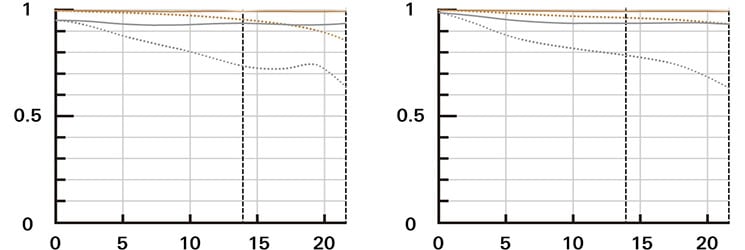
Above: Tamron 50-400mm f4.5-6.3 Di III VC, 50mm f4.5 (left), 400mm f6.3 (right)
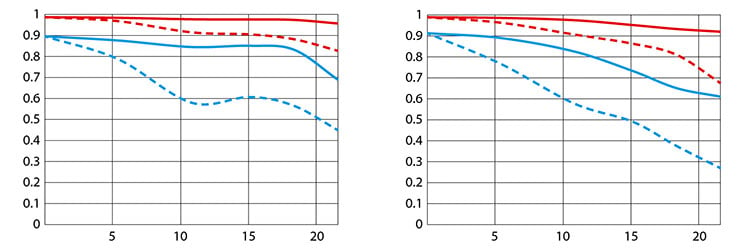
Above: Nikon Z 28-400mm f4-8 VR, 28mm f4.0 (left), 400mm f8.0 (right)
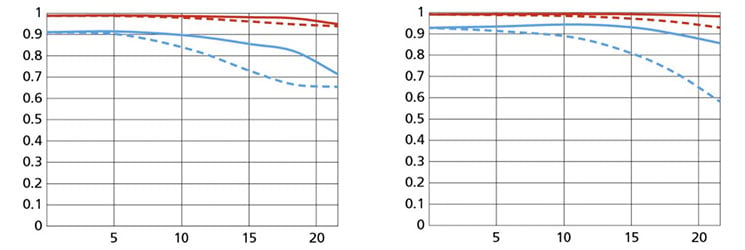
Above: Nikon Z 100-400mm f4.5-5.6 VR S, 100mm f4.5 (left), 400mm f5.6 (right)
These MTF charts show the computed lens-performance of lenses wide open without influence of diffraction at 10 line-pairs/mm (red/yellow) and 30 lp/mm (blue/grey). Higher values are better (more contrast) and the closer the dotted and solid lines are together the less contrast dependents on the orientation of the test-pattern (less astigmatism). The x-axis displays the distance from the optical axis (=center of the sensor) in mm.
Comparing the short end of the three lenses is pretty risky as the focal lengths are very different and performance of a lens can change pretty fast once you zoom from 28mm to 50mm or 100mm. Comparing the lenses at 400mm focal length is more meaningful although the three lenses have different focal ratios. Looking at contrast and astigmatism of finer structures (30 lp/mm) the Z 28-400mm should be the softest of the three lenses and the Z 100-400mm the sharpest. The Tamron 50-400mm f4.5-6.3 Di III VC lies in the middle, possibly performing closer to the Z 100-400mm than to the Z 28-400mm.
We’ll see how this theoretical performance translates into real-life results in my full review of the Z-mount version on a Nikon Z8 – including 180MP pixel-shift test-shots. But if you’re curious how the E-mount version of the Tamron performed on a 42MP Sony A7R II head over to my Tamron 50-400mm f4.5-6.3 Di III VC review.
Check prices on the Tamron 50-400mm f4.5-6.3 Di III VC VXD at B&H, Adorama, WEX UK or Calumet.de. Alternatively get yourself a copy of my In Camera book, an official Cameralabs T-shirt or mug, or treat me to a coffee! Thanks!